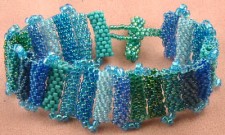Peyote stitch beading is often thought of as being very regular in appearance. However, peyote beading can be very organic and free form as well. So what’s the difference?
Peyote Beading Background

What we know as the peyote stitch is also known in Native American culture as the gourd stitch. However, contrary to popular belief, the Native Americans did not invent this style of beading. In fact, there have been Egyptian artifacts demonstrating the stitch, pre-dating the discovery of Americas.
It all goes to show you how popular this beading stitch is!
Peyote:Â Flat and Tubular
There are four major kinds of peyote: flat versus tubular and odd versus even. I had a hard time deciding what to cover first, but I’m going with flat and tubular first.
As you can probably guess, flat peyote is worked as a flat piece of beading. Rows are worked across and back the piece. Flat peyote stitch is great for all kinds of projects, from earrings to bracelets to necklaces and more.
Tubular peyote is, well, tube-shaped. It’s worked around a central core, in kind of a spiral manner. Instead of working back and forth like you would in flat peyote, tubular works in one direction only.
Tubular peyote is often thought of as being just for necklaces, but it ain’t so! Various diameters of tubular peyote can also be used for bracelets and even earrings.
Odd and Even Peyote Stitch Beading
Now that you know what flat and tubular are, next up is odd versus even peyote.
The easiest peyote stitches are even count flat and odd count tubular. In both cases, you don’t need to do any special twists or turns or step-ups at the end of each row or round. If you’re just now learning the peyote beading stitch, a flat even count is easiest, followed by odd count tubular.
But what exactly do odd and even mean? It refers to how many beads you pick up for your starting row.
You can check out the peyote odd count video instructions for more information. Plus, here’s a free tutorial for learning even count flat peyote which includes a bracelet project. 🙂
Structured Versus Free Form
There’s one final breakout for peyote stitch beading, and that’s structured versus free form (sculptural).
Structured peyote stitch is perhaps better termed traditional peyote. It’s the standard 1-drop or 2-drop worked in flat or tubular form. Patterns are easy to chart and stitch.
Free form, however, is peyote seen through different eyes. The basic structure is present, but in a wholly different way. Rows can be worked horizontal, change to vertical or move off in a diagonal manner. Free form is fairly difficult to chart for a project. On the other hand, the good news is that even if you don’t follow the chart exactly, you’ll still get a great piece of jewelry!
I’ll leave you with a glimpse of the findings you’ll be needing to go with your peyote jewelry. These include ear wires, clasps and more. Enjoy!
[…] « Peyote Stitch Beading Overview Peyote Beading Stitch Even Count Flat […]